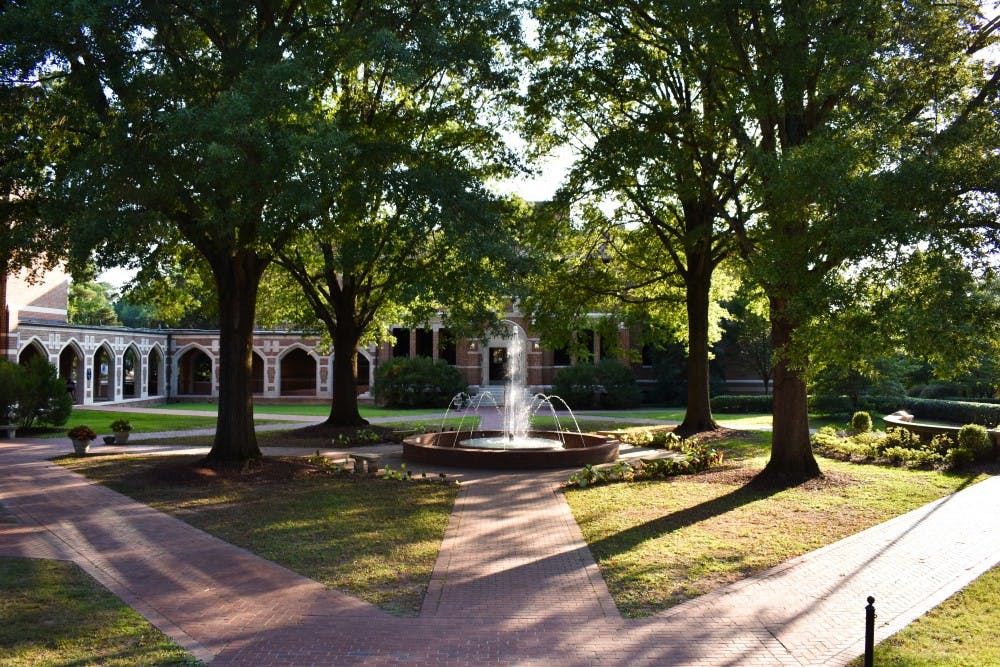A “Thriving and Inclusive University Community” is one of the five pillars of the University of Richmond’s strategic plan, “Forging our Future, Building from Strength," and has been a main focus for UR administration throughout the past year.
The President’s Advisory Committee for Making Excellence Inclusive (PAC), the Interim Coordinating Council for Thriving, Inclusion, Diversity and Equity (ICC) and the Presidential Commission for University History and Identity all contributed to the “Making Excellence Inclusive” report released by University President Ronald A. Crutcher on June 30 that proposed several changes to UR's policy and structure.
New Structures
In accordance with the report, a senior administrative officer (SAO) has been appointed to serve on the President’s Cabinet. Amy Howard will be the interim officer, reporting to Executive Vice President and Chief Operating Officer David Hale, as well as Executive Vice President and Provost Jeffrey Legro. Howard previously co-led the Bonner Center for Civic Engagement.
“Almost 100 people worked on these reports," Howard said. "Faculty, staff, students and alumni put in a ton of time and effort, but they’re not the only ones. There have been many people who have been working on these issues for many, many years at the institution, so it’s not new. This is just a chance to really take us forward and move the momentum to make the real change that we need to see to be a more thriving and inclusive campus.”
As interim SAO, Howard will be in charge of convening the ICC, composed of appointed faculty and staff members.
She also explained that her role would include setting up the relationship between the interim SAO, the President’s Cabinet and the ICC, and modeling this new distributed leadership structure that had been suggested by the ICC.
Recommendations and Initiatives
Senior Lindsey Paul was a student representative on the Thriving and Inclusion Metrics and Evaluation (TIME) subcommittee, contributing to the completion of the TIME report released in May. Paul is also the Westhampton College Government Association president.
“In all parts of the administration, what they really want is for students to be able to thrive, find community, enjoy their time here and get a lot out of it,” Paul said. “I think that with this report and with the other reports, their published mission is clear, and it’s exciting to see what is going to come of it.”
The TIME report, in conjunction with several other reports compiled by the PAC, ICC and Presidential Commission were reviewed by administration to create the Making Excellence Inclusive initiatives.
“There is a bold set of recommendations that we’re taking on in the next three years with clear accountability that’s in motion,” Howard said.
Enjoy what you're reading?
Signup for our newsletter
These recommendations focus on three main topics: representation, belonging and capability. Each initiative in the Making Excellence Inclusive report is listed with a corresponding faculty member who is responsible for overseeing its implementation and subsequent yearly evaluation.
Representation is defined in the report as “[c]ontinuing to recruit talented and diverse students, faculty, and staff to ensure our campus community reflects the rich diversity of our city, region, nation and the world.”
According to the draft institutional work plan in Appendix A, UR administration plans to “[e]xpand training and tools to support identification of student applicants from diverse backgrounds, including Environmental Context Dashboard (ECD).”
The plan also lists several other recruiting and hiring initiatives designed to advance inclusive representation across campus.
The second goal, belonging, is stated as “[c]ultivating inclusive living, learning, and work environments in which all can fully participate in the life of the institution and experience a sense of belonging.”
The draft institutional work plan states UR's plans to establish an online portal to assist students seeking financial support from the Career Opportunity Fund and Spiders Helping Spiders, while continuing to fundraise for these programs.
To further promote the ideal of belonging, members of a Health Services Review team will evaluate well-being services on campus and suggest changes and improvements.
UR administration will also conduct research, overseen by Hale and Howard, to determine the location of a potential burial ground of enslaved people on campus and design a corresponding memorial.
Several other actions for the goal of belonging include reviewing the new student orientation model and initiating a pilot program for employee resources.
Capability is described in the report as “[b]ecoming a skilled intercultural community that enables and enriches an unparalleled academic experience.”
To make progress in this category, UR administration plans to launch a training program and evaluate anti-bias, anti-racism, equity and inclusion training for faculty and staff members.
There will also be an academic initiative to explore UR’s intersectional history and its legacies, including the enlistment of a public historian.
The Office of Institutional Effectiveness will collect, analyze and share data with the President's Cabinet, ICC and SAO to measure the results and progress of these initiatives.
Demographic Data
For part of the report, the PAC enlisted Keeling & Associates, a higher education consulting firm, to direct on-campus interviews, conduct focus groups and collect survey data over a three-day campus visit in October 2018.
The findings included opinions from almost 200 faculty members, staff members and students.
Paul explained that the main priority of the TIME subcommittee had been to identify certain populations of students that weren’t thriving in areas such as representation, belonging and capability, and then establish ways to address these institutional shortcomings.
The statistics included in the report are broken down into several demographic categories, showing the variance in opinions on campus inclusivity among different groups of students.
For example, 91% of Asian students believed UR would benefit from a more diverse student body, but only 67% of white students agreed.
Similarly, 90% of black or African American students said they thought UR would benefit from a more diverse faculty, but only 64% of white students agreed.
For context, the campus’ compositional diversity included in the report is below.

Graphic courtesy of the Making Excellence Inclusive Report.
The goal of the recommendations in the Making Excellence Inclusive report is to account for these differences in feelings about inclusivity among varying demographics of students.
“I love this place and have gotten a lot out of it, but not everyone has,” Paul said. “Part of my personal goal and the goal of my position [on the TIME subcommittee] is to make this campus better for everyone that is here, and that means I want as many students to be thriving as possible.”
Senior Kidest Gebre discussed dealing with culture shock when she arrived at UR from her historically black high school but being helped by faculty members and student groups on campus.
Gebre also said she had noticed gradual changes on this campus, including that each incoming year of new students seemed to be more diverse than the last.
But she would like to see more large-scale changes for students of color on campus.
“Not that we shouldn’t celebrate slow strides, but there are much bigger issues that can be solved by putting the right amount of funding and effort in certain areas,” she said.
Gebre said she believed students could put a great deal of effort into promoting inclusivity in the structure of UR’s social scene.
The role of students is “making sure whatever happens on this campus is inclusive to everyone, especially student events, because the social scene can be segregated,” Gebre said. “And that’s on our part as students, we can try to get out of our comfort zone and integrate our events, socially and academically.”
Howard agreed it would take a collective effort to induce real change on campus.
“One person can’t do it,” Howard said. “If we’re going to change institutional culture, it’s going to take all of us.”
Contact sports editor C.J. Slavin at cj.slavin@richmond.edu.
Support independent student media
You can make a tax-deductible donation by clicking the button below, which takes you to our secure PayPal account. The page is set up to receive contributions in whatever amount you designate. We look forward to using the money we raise to further our mission of providing honest and accurate information to students, faculty, staff, alumni and others in the general public.
Donate Now



